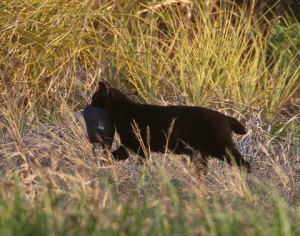Resolution 19-2: Keeping Cats Indoors & Using Peer-Reviewed Science
Posted on Feb 1, 2019 in News, slider
Feral cats (and chickens) eating food dumped at He‘eia state park on O‘ahu
On January 29, 2019, the Hawaii Invasive Species Council adopted a resolution supporting the keeping of pet cats indoors and the use of peer-reviewed science in pursuing humane mitigation of the impacts of feral cats on wildlife and people.
Background
Feral and free roaming cats are documented predators of wildlife. This predation is a particularly problematic issue in Hawaii, where a large proportion of native bird species are federally listed as threatened and endangered. Because Hawaii’s native birds evolved in a habitat free from mammalian predators, some have evolved to be ground-nesting birds. This behavior makes them especially susceptible to mammalian predation. Cats are the sole reproductive host of the parasite Toxoplasma gondii, commonly referred to as toxoplasmosis. Toxoplasmosis has been documented as the cause of death in both terrestrial and aquatic wildlife in Hawaii, including but not limited to the spinner dolphin, the endangered Hawaiian monk seal, the endangered alala, the endangered nene, and the red-footed booby. Toxoplasmosis also presents a health risk to humans, particularly immunocompromised individuals and pregnant women. Toxoplasmosis is associated with birth defects and miscarriage.

A feral cat at Honouliuli (Oahu) with a dead Hawaiian coot (federally listed endangered species). This cat has a notched ear, indicating that it is part of a managed colony. Credit: Michael Walther
Discussion
Pet cats live longer, healthier lives when kept indoors or contained within a given area. By keeping cats indoors or using outdoor mitigation strategies like fencing, leashes, or cat patios, negative interactions between pet cats and native wildlife in Hawaii can be minimized. Policy discussions regarding feral cats in Hawaii often revolve around a system referred to as “Trap-Neuter-Return,” or TNR. A variant of this system is “Trap-Neuter-Return-Manage,” or TNRM. In either case, feral cats are trapped by interested individuals, neutered, and then re-released onto the landscape, often on public property or on property not owned by the individual providing care for the released cats. The system further encourages the maintenance of “cat colonies” in the wild by a caregiver often providing food for cats. In theory, TNR is a tool for reduction in the number of feral cats on the landscape, since the cats are neutered and eventually die in the wild of disease, injury, or other causes. TNR as a system has been researched in a number of scientific, peer-reviewed studies, summarized in a meta-analysis titled “Critical Assessment of Claims Regarding Management of Feral Cats by Trap-Neuter-Return” by Longcore et al (2009) in the journal Conservation Biology. This analysis has shown TNR to be ineffective at its primary goal of reducing the number of cats on the landscape. TNR also does not mitigate the primary impacts of feral cats on native wildlife or humans: neutered, re-released cats can continue to prey on native wildlife and continue to spread disease that is harmful to wildlife and humans.
Legal Authority
• HRS 194-2 (a): Establishes the HISC for the purpose of cabinet-level coordination and planning among state departments, federal agencies, and international and local initiatives
• HRS 194-2 (a)(2): Advise, consult, and coordinate invasive species-related efforts with and between the departments of agriculture, land and natural resources, health, and transportation, as well as state, federal, international, and privately organized programs and policies.
Resolution 19-2: Supporting the Keeping of Pet Cats Indoors and the Use of Peer-reviewed Science in Pursuing the Humane Mitigation of the Impacts of Feral Cats on Wildlife and People